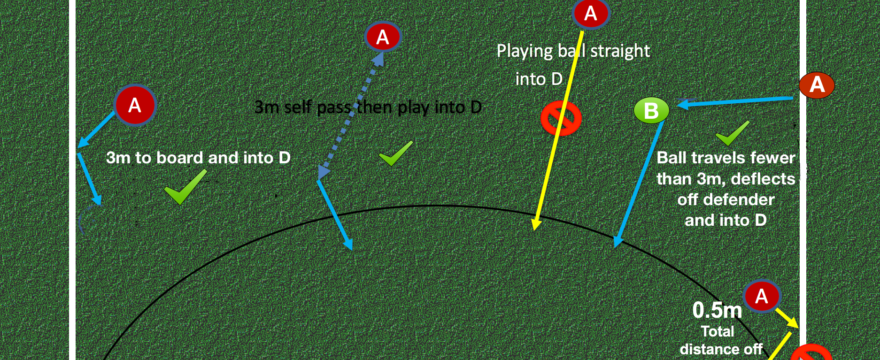To score a goal each of the following criteria must be met: the ball must be played inside the circle (which includes the circle line),the ball must be struck or touched by an attacker's stick …
Match Timing – Rule 5
Time-outs have been removed in the 2019 Rules and replaced with quarter-time breaks. …
Clothing and Equipment – Rule 4
All members of one team, except the goalkeeper, should all wear the same colour, e.g. red shouldn’t play against red. Players must not wear anything dangerous to other players: peaked caps, sharp …
Dealing with Injuries – Rule 2.7
Accidents can happen at any time during a game and it is the umpire's decision on whether the injury is serious enough to: call an immediate stoppage of time,call a stoppage of time at a convenient …
Ball Out Of Play – Rule 7
A 9m free push is awarded to the defending team after the attacking team has sent the ball over the back-line and no goal has been scored. The following elements are required: the free push is …
Start and Restart a Match – Rule 6
Methods of starting and re-starting play fall into three general categories: Starting play: centre pass or bullyBall outside the pitch: 9m free push or a free push within 1m of where the ball …
Teams & Substitutions – Rule 2.3
A maximum of 6 players from each team are allowed on the field at any one time during the match. Each team may play with: A goalkeeper wearing protective equipment comprised of at least headgear …
Captains – Rule 3
There must be a captain on each team. Captains are responsible for the conduct of their players. They should make sure everyone behaves properly and that substitutions are carried out properly. A …
The Match and Result – Rule 5
Leagues and competitions can specify different durations, but top-level domestic and all international competitions should follow this format. All indoor games should run 4 x 10 min. quartersThe …
Rule 2 – Composition of Teams
A maximum of 6 players from each team are allowed on the field at any one time during the match. Each team may play with: A goalkeeper wearing protective equipment comprised of at least headgear …
The Pitch – Rule 1
Field and Equipment Specifications Indoor field hockey is played on a rectangular field with side-boards: Minimum 36m long and 18m wide Maximum 44m long and 22m wide The field has …
Responsibilities of an Umpire
Umpiring is a rewarding and challenging experience at all levels of hockey. Having now attended the Indoor Umpiring course you have the opportunity to umpire and put your skills and knowledge to the …
Becoming a Provincial Indoor Umpire
Successful completion of the course entails: Practical Assessment: To be assessed for the indoor Provincial certification, matches need to be of an even matched level of play at local club league …
Continue Reading about Becoming a Provincial Indoor Umpire →
FHC Indoor Umpiring Structure
Tips For Better Umpiring
Below is some basic advice to help you achieve your goals as an umpire, by being proactive, responsible and committed to your umpiring appointments, you, in turn, will help your field hockey …
Timing and Duration
Following the rather unpopular move in outdoor matches towards quarters which have only been implemented at the highest domestic levels in many countries, the 2019 indoor rules follow suit. 4 x …
No PWGKP
As was done for the outdoor rules, the option for teams to use a Player With Goalkeeping Privileges (aka a "kicking back") has been removed for indoor as well. All Field Players, All The …
Free Pushes Inside the 3m Dotted Line
In yet another synchronization change, those pesky free pushes awarded for fouls inside the 3m dotted line are being treated just like their equivalent in outdoor. If the free push is taken quickly …
Continue Reading about Free Pushes Inside the 3m Dotted Line →
Tweaking (Not Twerking) Penalty Corners
As already set out in the first unit, one of the big changes is that time is now stopped when a penalty corner is called, and restarted when the umpire blows to indicate the corner can go ahead. …
Continue Reading about Tweaking (Not Twerking) Penalty Corners →
Too Many Players
In the past, the way we've handled too many players on the pitch has been different between indoor and outdoor. Under the 2019 rules it's not the exactly same, but it's getting closer. In …
You Did It!
Yup, time to be super proud. You've finished the course and successfully passed the exam. So what's next? If you're in the CLFHA, contact your team rep or the league coordinator to be appointed to …
Indoor Provincial Exam
Psychological Skills & Tips
Relaxation Physical and mental relaxation can help to manage anxiety. Possible coping techniques include: Deep breathing/breath control that is smooth, deep and rhythmical Slow down; have …
Fitness
Today’s hockey has put an ever-increasing physical as well as mental demand upon umpires. Physical Fitness Players’ standards of preparation and performance have intensified to such a degree …
Whistle Technique
Use of the Whistle the whistle is the main tool of communication for an umpire hold the whistle in your hand until you make a call - this allows you to use your voice and be proactive with …
Maintaining Control
Below are listed some common problems exhibited by umpires. You can improve your control of the game by being aware of these tendencies, and working to eliminate them from your umpiring. Guessing: …
Game Management and Control
Any game at any level can be very stressful for the umpire. The presence of spectators, the tension created by anxious players and coaches and the pressure of the match itself all contribute to …
Penalty Stroke Positioning
As the controlling umpire, you have the lion's share of responsibility for the penalty stroke you have awarded. You are looking for: The stroke-taker is starting behind the ball The goalkeeper …
Penalty Corner Positioning
Penalty Corners The controlling umpire: must be in a position to see the injection and the end line simultaneously to detect any early breaking, must be able to see whether the ball has …
Supporting Umpire Positioning
There are two movements to consider when supporting your colleague, depending on which general side the ball moves away from you. When the ball moves up your near side boards, your priority needs …
Controlling Umpire Positioning
9m Free Push As the controlling umpire, you want to be either behind the last defender playing the ball out, or at least in front of the highest attacker. How far up the pitch you go will depend on …
Turnover Drill
One of the traps we fall into when we're new to umpiring is THINKING. Your brain is deadly; keep it out of umpiring as much as possible. The problem is that when we think--perhaps about the last …
Positioning
"Positioning" means being in the best possible place to see the play, at the right time. The "best" position is the one that allows the umpire to observe everything play closely but doesn't cause …
Pre-Match Chat
The two umpires should always try to have a chat about the game you will umpire, no matter how brief. This will help with your communication, teamwork, consistency in making the calls and your own …
Team Umpiring
Regardless of your experience as an umpire, team umpiring is a must on and off the field. A strong “team” of umpires, united for the match, will do much to contribute towards a well-controlled, …
What Makes a Good Umpire?
The umpire is a very important and necessary part of every game. Each umpire has a responsibility to ensure that games proceed safely and fairly within the spirit of the rules. Careful study of the …
How to Award a Card
Umpires often say that giving cards is the most difficult aspect of the game. A few others actually enjoy giving them and can even struggle to conceal their glee when the opportunity arises. Neither …
The Floors
1. Warning: cautioning by use of words and/or body language and/or whistle tone The first level of communication involves using any combination or all of a loud, sharp whistle blast, hand motions …
The Control Elevator
In addition to the appropriate team penalties described previously, any player may also be given a personal penalty in the form of a card for an offence. Personal penalties should be considered for …
Managing the Penalty Stroke
Managing the Penalty Stroke If the penalty corner is the biggest common call you'll make in the game, the penalty stroke is the rarest of the even bigger calls. Everything that applies for the …
Taking the Penalty Stroke – Rule 13.8
The Penalty Stroke: the signal also indicates time stoppedno undue delay in preparation for the stroke by players be proactive to prevent a goalkeeper from taking off all of their equipment just …
Continue Reading about Taking the Penalty Stroke – Rule 13.8 →
Penalty Stroke – Rule 12.4
A penalty stroke is awarded when a defender: commits an unintentional foul in the circle which prevents a probable goal from being scored, orcommits an intentional foul in the circle against an …
Managing the Penalty Corner
Managing the Penalty Corner - In Detail The penalty corner is the most common "big call" you're going to make in a game. This is where you can flex your management muscle by having a strong …
Completing Penalty Corners – Rule 13.4-13.6
At The Quarter Ends and Full-Time the game is prolonged to complete a penalty cornerif another penalty corner or penalty stroke is awarded the game will be prolonged again to complete of the …
Continue Reading about Completing Penalty Corners – Rule 13.4-13.6 →
Taking Penalty Corners – Rule 13.3/13.7
The Attack the ball is placed on the back-line at least 6 metres from the goalpost on whichever side the attacking team preferswhen the umpire is ready, they will blow their whistle to signal the …
Continue Reading about Taking Penalty Corners – Rule 13.3/13.7 →
Awarding Penalty Corners – Rule 12.3
The 5 reasons for awarding a PC are when: there is an unintentional breach of the rules by the defending team inside the circlethe defending team intentionally plays the ball over their own …
Continue Reading about Awarding Penalty Corners – Rule 12.3 →
Attacking Free Push Inside 3m Dotted Line – Rule 13.2
For attacking free pushes inside the 3m dotted line: The free push is taken from the spot of the foul. Defenders inside the circle caught within 3m of the free push being taken when the …
Continue Reading about Attacking Free Push Inside 3m Dotted Line – Rule 13.2 →
Free Pushes Inside Attacking Half – Rule 13.2
Free Pushes Inside the Attacking Half All players must be 3 metres awayan attacker can only play the ball into the circle after it has travelled 3 metres (including if it is played off the side …
Continue Reading about Free Pushes Inside Attacking Half – Rule 13.2 →
Taking the Free Push – Rule 12.2/13.1-13.2
Awarding the Free Push A free push is awarded for: an offence by an attacker in the half of the pitch they are attackingfor an unintentional offence by a defender outside the circle Taking a …
Continue Reading about Taking the Free Push – Rule 12.2/13.1-13.2 →
All Field Players – Rule 2.2
A team may elect to play without any type of goalkeeper (for example, they lack a helmet). In that situation, all 6 field players on the court will be in the same colour of shirt and no player has …


